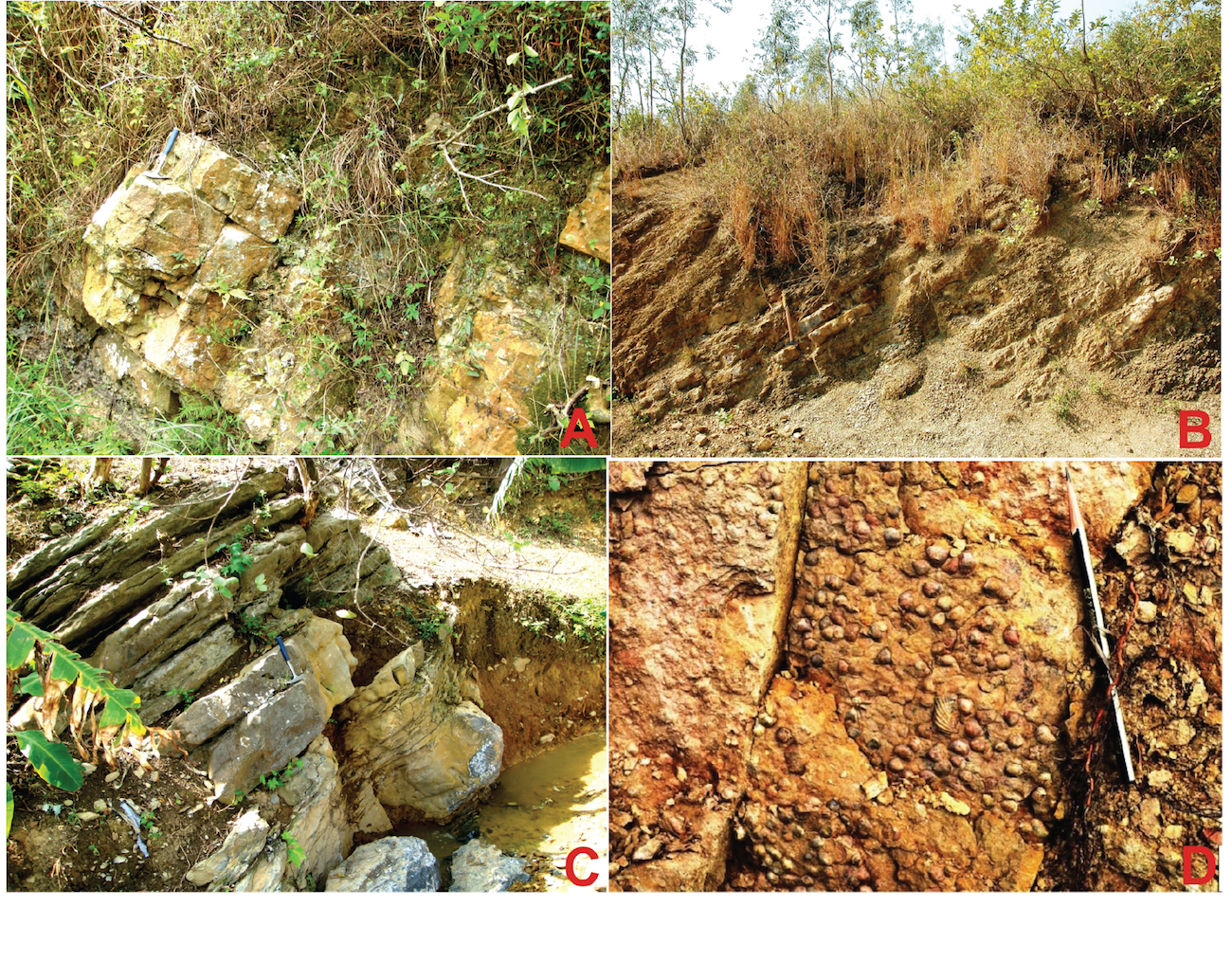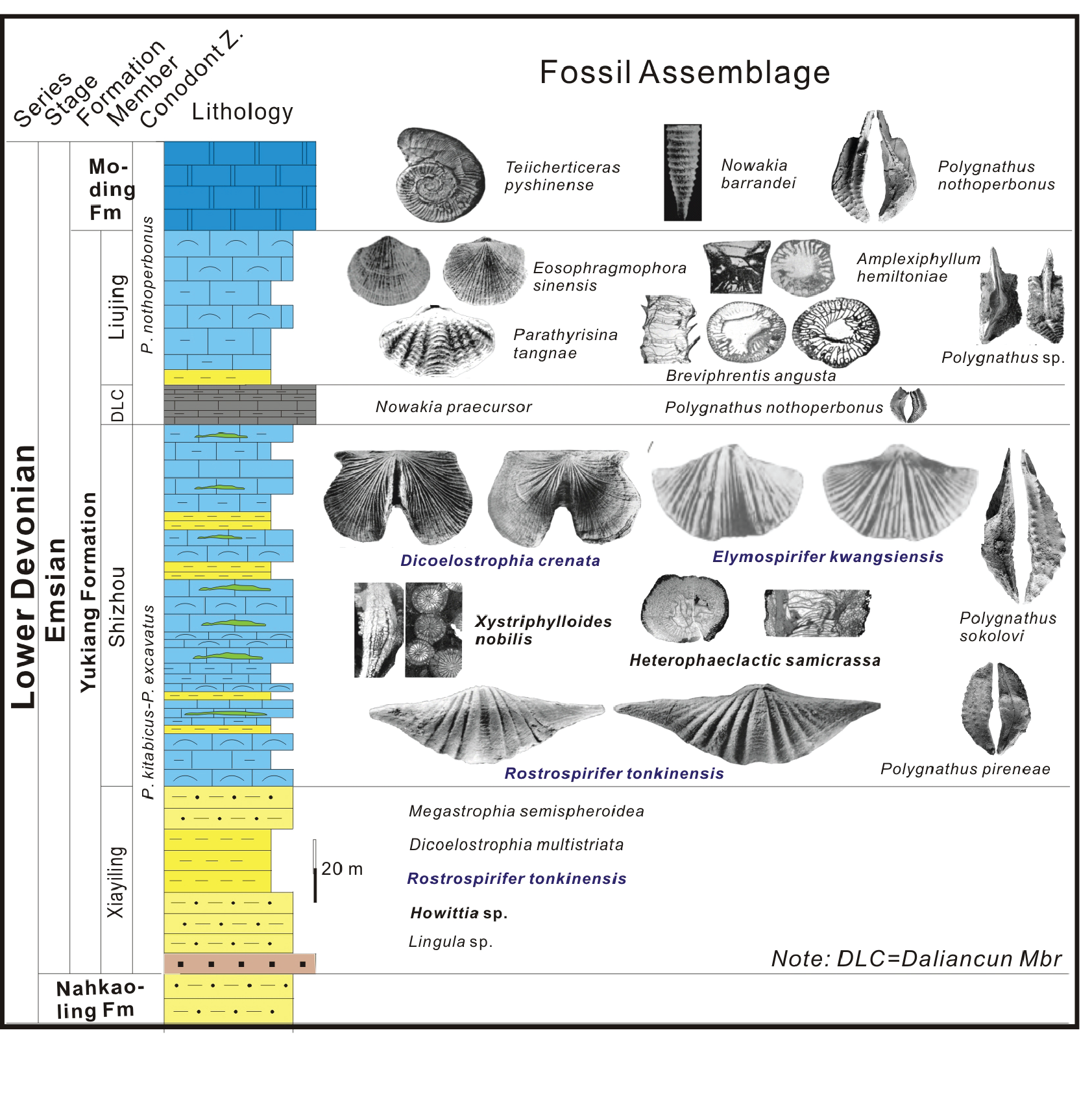Yukiang Fm
Type Locality and Naming
The type section is located at the southern slop of the Xiayiling Mt. across the Shizhou village to near the railway station of Liujing in Liujing Town, Hengxian County, about 60km east of Nanning, the capital city of Guangxi Zhuangzu Autonomous Region. It was named by Zhao Jinke (=Chao K.K.) in 1947.
Synonym: Yujiang Fm.
[Figure Simplified geological map of Liujing area showing the location of type sections of some lithostratigraphic units (red lines) A-Nagaoling Fm, B-Yukiang Fm, C-Moding Fm, D-Najiao Fm, E-Mintang Fm and Gubi Fm.]
[Figure Simplified geological map (top left) showing the cross sections of A: Nagaoling Fm. B: Yujiang (Yukiang) Formation and the satellite map (red star indicating the Railway Station of Liujing). The bottom map shows the location of Liujing in southern Guangxi.]
Lithology and Thickness
Clayey limestone. The Formation is divided into four members:
Lowermost Xiayling Member, about 50 m thick, consists of gray yellow fine-grained sandstone in the base and alternation of siltstone and mudstone in the upper part.
Lower, Shizhou Member, 106 m thick, the uppermost part of which is thin- to medium-bedded yellowish gray marls, mudstones and bioclastic limestones intercalated with silty mudstones; the middle part yellowish to greenish gray silty mudstones and bioclastic micrites; the lower part medium to thick bedded greenish gray silts bearing marls intercalated with silty and dolomitic limestones and bioclastic limestones.
Middle, Daliancun Member, 12 m thick, is composed of medium to thick-bedded dark gray to blackish mud-bearing bioclastic limestones intercalated with nodular biogenic marls.
Upper, Liujing Member, 45 m thick, the top part is brownish and reddish, thin-bedded, bioclastic and micritic limestones and marls, the upper and a middle parts consisting of grayish thin-bedded bioclastic limestones and marls; the lower parts with yellowish gray mud-bearing micritic limestones intercalated with thin-bedded shelly limestones..
[Figures - Photos showing the representative outcrops: A- Basal sandstone beds of the Xiayiling Member; B- Marls with thin beds and lenses of limestone of the Shizhou Member; C- Limestone beds of the Daliancun Member; D- Shelly beds of the Liujing Member.]
Relationships and Distribution
Lower contact
The Formation rests conformably on the Nagaoling Fm Shale in most areas, but onlaps unconformably on Upper Cambrian with basal conglomerates in west Guangxi and southeast Yunnan.
Upper contact
It is conformable contact with overlying dolomitic limestone with siliceous bands at the base of the Moding Fm
Regional extent
The Formation is only distributed in the south of Liuzhou, northwest Guangxi and southeast Yunnan. It consists mainly of mudstone and siltstone in northwest Guangxi and southeast Yunnan. In the Dale of Xiangzhou, the northern end of distribution area of the Formation, it is composed of sandstone but only the uppermost clayey limestone of 10 m thick can be correlated with Liujing member.
GeoJSON
Fossils
It contains abundant benthonic fossils dominated by brachiopods and corals with some gastropods, bivalves, stromatoporoids, bryozoans, trilobites, tentaculites and conodonts. In the basal Xiayiling Mbr. some plant fragments with Lingula sp. are dominated.
Brachiopoda is characterized by Rostrospireifer fauna and can be divided into two successive assemblage zones: Rostrospirifer tonkinensis-Dicoelostrophia crenata Ass. Z. below and Eosophragmophoria sinensis-Parathyridina tangnae Ass. Z. above (Hou and Xian, 1964; Wang and Rong, 1986; Hou et al., 2017).
Corals are characterized by Xystriphylloides nobilis-Heterphaulactis semicrassa Ass. Z. including the following genera Calceola, Microcyclus, Siphonophrentis, Nardophyllum, Breviphrentis Pseudomicroplasma (Yu et al., 1979).
The bivalves Caneyella? Yujiangensis - Cimitaria guangxiensis - Phestioidea obtuse Assemblage has been erected, which is characterized by the lack or almost disappearance of Dysodonta and Leiodydodonta and being replaced by Antactinodion. (Zhang et al., 1988; Pojeta & Zhang, 1984).
Trilobites occurred in the lower part of Shizhou Member are species referred to Lobopyge, Lacunoporaspis, Acanthopyge, 'Basidechenella', Proetus, Dinolichio, etc., and appeared in the upper part are species referred to Schizoproetoides and Gravicalymenes. In the Liujing Member that only 'Basidechenella' liujingensis, Gravicalymene sp., Phacops sp. have been found, which are extended from the Shizhou Member.(Kuang et al.,, 1989). The Gravicalymene maloungkaensis Zone has been established for the trilobites occurred in the Yukiang Formation (Zhong et al., 1992)
Bryozoans have been described by Yang (1954) including 24 species referred to 11 genera. Semicoscinium striatum, Fenestella cf. elongate, Eridotrypella sinensis, Monotrypa nanningensis, Fistuliramus sp., Leptotrypella sp. are found in the Shizhou Member and extended to Liujing Member; and Fistulipora lamellose, F. oblongata, F. kwangsiensis, F. frondosa, Fenestella sp., Cystiramus sp. being occurred in the upper part of Daliancun Member.
Individuals of receptaculitids are locally assembled in the upper part of Daliancun Member but remained for detailed study.
Conodonts Polygnathus sokolovi and Pol. pireneae are firstly occurred from the basal Shizhou Member and more elements are found in the Daliancun Member including the Pol. e. excavatus and Pol. northoperbonus (Lu et al., 2017).
[Figure - Columnar section of Yukiang Formation with main marker fossils]
Age
Depositional setting
The lithology and fossils suggest that a transgressive trend from a tidal flat setting; in that a bioherm was developed locally.
Additional Information


